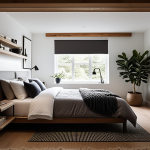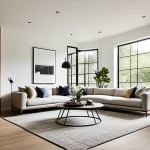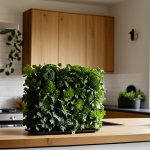Understanding Minimalist Home Decor
Minimalist home decor embodies simplicity, function, and intentionality—the core concepts of minimalism. At its essence, minimalist design principles focus on stripping away excess to reveal only what is necessary and purposeful. This approach contrasts sharply with more ornate or cluttered decor styles, offering a clear, calm aesthetic that highlights the beauty of essential elements.
Key to minimalist home decor is the idea that every object, colour, and piece of furniture serves a specific function without overwhelming the space. Instead of filling rooms with decorative items, minimalism encourages deliberate choices that enhance usability and visual clarity. For example, neutral colour palettes paired with clean lines and unembellished surfaces strengthen the minimalistic feel by avoiding distractions.
Also to discover : What Steps Does the UK Government Take to Ensure National Security?
Differentiating minimalist style from other decor movements involves understanding its rejection of excess for the sake of elegance rooted in practicality. Unlike maximalist or eclectic designs, minimalist spaces aim to foster a sense of openness and tranquility. When applied thoughtfully, minimalist home decor creates environments that feel balanced and harmonious, enriching everyday living through focused simplicity.
Understanding Minimalist Home Decor
Minimalist home decor is centered on simplicity, function, and intentionality—the core concepts of minimalism that guide every design choice. It defines a lifestyle and aesthetic that focuses on eliminating excess to highlight what truly matters. Unlike ornate or maximalist styles, minimalist design principles emphasize clean lines, uncluttered spaces, and purposeful use of each element.
Also to see : How Can Your UK Home Decor Reflect Your Personality?
At its essence, minimalist home decor prioritizes decluttering and streamlining environments to create calming, efficient spaces. This means every item serves a function or adds meaningful aesthetic value. The minimalist style avoids unnecessary ornamentation or complexity, distinguishing it from other decor movements like traditional or bohemian, which often encourage abundance and variety.
Intentionality drives minimalist choices: furniture, colours, and accessories are carefully selected to support simplicity without sacrificing comfort or personality. The result is a balanced environment where sightlines are clear, and the space feels open and breathable. Understanding these principles allows homeowners to transform their spaces into tranquil retreats aligned with minimalist ideals.
Transformational Impact of Minimalism in Your Living Space
Minimalist transformation changes both the look and feel of your home by emphasizing space, order, and purpose. By applying the benefits of minimalism, rooms become visually calmer and functionally more efficient. This approach removes unnecessary clutter, allowing natural light to flow and surfaces to breathe, which enhances the overall ambiance.
The psychological effects of these changes are significant. A minimalist home decor promotes calm, focus, and clarity by reducing distractions. As a result, occupants often report lower stress levels and greater mental clarity, creating a sanctuary within their living environment. Imagine entering a room where every item has its place and purpose—this environment supports mindful living.
Aesthetic upgrades naturally follow minimalist principles. Consider swapping bulky furniture for sleek, streamlined pieces that maximize space without sacrificing style. Neutral colour palettes, another benefit of minimalism, contribute to a soothing atmosphere, making rooms appear larger and more inviting. Spatial enhancements such as open shelving or multi-functional furniture demonstrate how minimalist transformation both elevates design and improves home environment functionality. These tangible benefits underscore why minimalist design principles are valued beyond mere aesthetics.
Transformational Impact of Minimalism in Your Living Space
Minimalist transformation brings profound visual and functional changes to interiors. By applying minimalist design principles—such as eliminating clutter and focusing on essential items—rooms appear larger, brighter, and more open. Removing unnecessary objects sharpens spatial flow and encourages better use of natural light, improving both aesthetics and practicality.
The benefits of minimalism extend beyond appearances. Psychologically, such spaces foster calm, focus, and clarity. When environments are free from distraction, the mind can relax and concentrate. This emotional improvement highlights a core concept of minimalism: intentional space supports intentional living.
For example, replacing bulky furniture with streamlined pieces creates an uncluttered atmosphere conducive to relaxation. Choosing neutral palettes and smooth surfaces further enhances this effect by reducing visual noise. Additionally, minimalist transformation often leads to better organisation, reducing stress related to cluttered living.
Thus, adopting minimalist home decor is a practical way to improve your home environment, enhancing both form and function while promoting mental well-being. Minimalist design principles ensure these changes are not fleeting but sustainable, aligning your living space with the core concepts of minimalism for lasting impact.
Understanding Minimalist Home Decor
Minimalist home decor centers on the core concepts of minimalism: simplicity, function, and intentionality. These principles guide all design choices, ensuring that every element in a space serves a clear purpose without excess. Minimalist design principles emphasize clean lines, open layouts, and a restrained colour palette to foster a calm, uncluttered atmosphere.
Simplicity in minimalist home decor means reducing visual noise by limiting decorative objects and choosing plain, elegant furniture. Function complements this by prioritizing pieces that offer usability and contribute to daily living efficiency. Intentionality ties these together by encouraging deliberate decisions about what belongs in a room and why.
How does minimalist style differ from other decor movements? Unlike maximalist or eclectic styles that embrace abundance and vibrant variety, minimalist home decor focuses on the essentials. Where bohemian or traditional designs celebrate texture and pattern layering, minimalism seeks balance through restraint and harmony. This distinction ensures that spaces feel spacious yet warm, promoting relaxation rather than distraction.
By understanding these fundamental minimalist design principles, homeowners can cultivate living environments that reflect thoughtful simplicity and purposeful elegance.
Understanding Minimalist Home Decor
Minimalist home decor epitomizes the core concepts of minimalism: simplicity, function, and intentionality. At its heart, this design philosophy involves removing excess to focus on what truly matters. By adhering to minimalist design principles, each piece of furniture, colour choice, or decorative element serves a clear purpose, eliminating clutter and visual noise.
Simplicity means prioritising clean lines and pared-down aesthetics; it avoids ornate or complicated details. Function ensures every object enhances usability, creating spaces that support daily life efficiently rather than just visually pleasing arrangements. Intentionality demands thoughtful selections—no item is placed without reason. This deliberate approach distinguishes minimalist home decor from other styles that favor abundance or eclectic mixes.
Unlike maximalist or bohemian designs, which embrace variety and rich textures, minimalist home decor fosters calm and spaciousness. It encourages open layouts and restrained colour schemes, often neutral, to establish a serene atmosphere. These minimalist design principles transform homes into environments that promote calmness, clarity, and purposeful living while maintaining elegant simplicity. Understanding these elements is key to recognizing how minimalist home decor differs and why it continues to resonate with those seeking balanced, intentional spaces.
Understanding Minimalist Home Decor
Minimalist home decor revolves around the core concepts of minimalism—simplicity, function, and intentionality. These minimalist design principles demand reducing spaces to essentials, giving priority to both usability and clarity. Simplicity means focusing on clean lines and minimizing visual clutter, so rooms feel open and uncluttered. Function insists that every chosen item has a clear purpose, improving daily living rather than merely decorating. Intentionality requires mindful decisions about each element, ensuring no piece is superfluous.
How does minimalist style differ from others? Unlike maximalist or eclectic decor, which embraces varied textures, colours, and objects, minimalist home decor strips down to essentials, avoiding excess. While bohemian or traditional styles layer patterns and accessories, minimalism creates balance through restraint and deliberate simplicity. This distinction makes minimalist environments feel calm, spacious, and welcoming, rather than visually busy.
Applying minimalist design principles consistently results in homes that feel balanced and thoughtful, supporting peaceful living. These defining features truly set minimalist decor apart, helping homeowners create purposeful, well-functioning, and serene interiors.
Understanding Minimalist Home Decor
Minimalist home decor centers firmly on the core concepts of minimalism—simplicity, function, and intentionality—each shaping how spaces are conceived and used. The essence of minimalist home decor lies in prioritising only what is essential, ensuring every item contributes directly to the room’s purpose or aesthetic without excess.
Simplicity means choosing clean lines and avoiding ornate details, which limits visual distractions and fosters a serene atmosphere. Function emphasizes that every element should have practical value, supporting daily living efficiently. Intentionality guides the thoughtful selection of objects, insisting no piece is placed without clear reason, reflecting deliberate design over impulse.
How does minimalist style differ from other decor movements? Minimalist home decor contrasts distinctly with maximalist or eclectic styles, which encourage abundance and variety. Instead of layering textures or vibrant colours, minimalist design principles focus on restrained palettes and open layouts. This approach creates spaces that feel spacious and calm rather than busy or overwhelming.
By adhering to these minimalist design principles, homeowners achieve harmonious environments that promote relaxation and clarity, setting minimalist home decor apart as a timeless and purposeful choice.
Understanding Minimalist Home Decor
Minimalist home decor is defined by the core concepts of minimalism: simplicity, function, and intentionality. Simplicity involves reducing visual clutter through clean lines and restrained palettes, creating open and tranquil spaces. Function emphasizes that each item should serve a practical purpose, enhancing the day-to-day usability of the space. Intentionality guides thoughtful decisions where every piece is deliberately chosen to add value.
How does minimalist home decor differ from other styles? Unlike maximalist or eclectic trends known for layering textures, colours, and patterns abundantly, minimalist design principles focus on essentials only. The minimalist approach avoids excess decoration, favoring clear sightlines and uncluttered layouts. This creates an environment that feels calm, spacious, and balanced rather than busy or chaotic.
This design philosophy optimizes living spaces not just visually but functionally. It supports clear mental focus by eliminating distractions, making rooms more purposeful and pleasant to inhabit. These fundamentals establish why minimalist home decor remains distinct—and enduring—among interior design movements, perfectly catering to those seeking refined simplicity and practical elegance.






